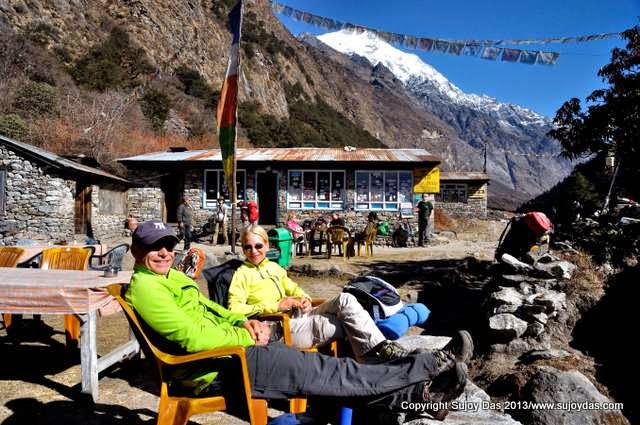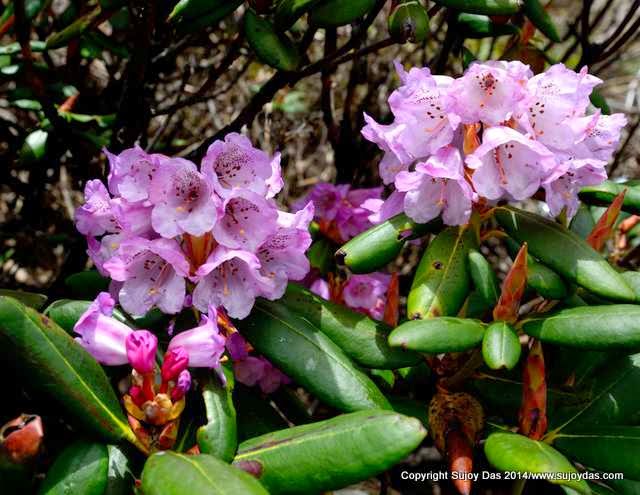Amongst the three major trekking areas in Nepal, namely, Everest, Annapurna and Langtang, the Langtang valley is the most under trekked. Most of the big name peaks are in the Everest and Annapurna regions, so Langtang has always come third when selecting a trekking destination. In many ways this is real pity because Langtang offers pristine forests, rich bird life, monastic culture and above all some spectacular mountain views of the Langtang Himal topped by the shapely Langtang Lirung. The cost of the trek is Rs 45,000/ per person for Kathmandu to Kathmandu (9 days) for SAARC citizens and USD 1000 for foreigners as per the itinerary below. Exclusions apply. For a detailed trek pdf do e-mail me at sujoyrdas@gmail.com.
TREK SCHEDULE
Day 01 Kathmandu to Syabrubesi (1470m) by road
The journey should take 6 to 8 hours depending on traffic and mode of
transport.
Day 02 Syabrubesi to Lama Hotel (2470m) 1070m ascent 7 to 8 hours
From Syabrubesi walk
up the main road and then take the right hand fork and descend to the river.
Before the bridge you come to a check post where the permits are verified.
Cross the bridge and climb up to a small village. Walk through the village for
about five minutes and then come to another bridge. Do not cross this bridge
and carry on along the same bank of the river. After about an hour or so, you
will reach the New Bridge Ayusiddhi Lodge at Tiwari. Cross this bridge and walk
upstream through a very pleasant forested track. In about two hours from
Syabrubesi you will come to Doman next to a huge waterfall. From Doman climb
uphill and then downhill and in about 30-40 minutes reach the lodges of Pairo.
From Pairo the trail is through the forest and in about 90-100 minutes reached Bamboo
which is the first day’s lunch stop.
Leave Bamboo after lunch and continue to climb through the forest past
waterfalls. About an hour from Bamboo the trail crosses another bridge with
“Welcome to Langtang” signposted on top. There is a small tea house across the
bridge. The trail then begins to climb
steadily for about an hour to Lower Rimche . Upper Rimche is about 20 minutes away with two lodges and
lovely sunset views. If you are continuing to Lama Hotel for the night stop it
is about 20 minutes from Rimche. This can be quite a long day and if you are
not sure, it is suggested to stop at Bamboo.
Syabrubesi to Doman – 2 hrs; Doman to Pairo 40
min; Pairo to Bamboo 1 hr 15 min; Bamboo to Lower Rimche 1hr 30 min; Lower
Rimche to Upper Rimche 20 min. Upper Rimche to Lama Hotel 20 min.
Day 03 Lama Hotel to Ghora Tabela (2970 metres) to Langtang Village
Leaving Lama Hotel
the trail winds through oak and rhododendron forests. Keep a look out for
birds, I spotted a Khalij pheasant here! Within forty minutes the Langtang
peaks come into view framed by the trees. The pleasant stop of Riverside
Lama Hotel to Riverside 1 hr 15 min; Riverside to
Woodlands 20 min; Woodlands to Ghora Tabela 1 hr.Ghora Tabela to Thangysyap 1
hr 15 min; Thangsyap to Chamki 30 min; Chamki to Langtang Village 1 hr 30 min.
Day 05 Rest and Acclimatization
day at Langtang Village
We are now at 11,000 feet plus so a rest day for
acclimatization is recommended.
Day
06 Langtang Village to Kyanjin Gompa (3860m) 460m ascent (3 to 4 hours) The trail climbs through Langtang village pass some marshy flats
which could be iced over in late autumn/winter. It then ascends in a series of
zig zags to Mundu village (30 to 40 min). From Mundu reach Sedum in around 20
min. The valley now begins to open up and Gina Chhenpo presents a dress circle
view at the head. From Sindum the trail
follows the river uphill and reaches the “Big Rock Café” in around 40 minutes.
Stop for a cup of tea here – Kyanjin is still an hour away. The trail descends
to the river and in the distance a white chorten can be seen – the entrance of
Kyanjin. From the river it is about thirty minutes to the chorten. Cross the bridge
over the fast flowing Langtang Khola and meander over flats climbing gently
until Kyanjin Gompa is reached.
Day 6 Rest Day at Kyanjin Gompa The rest day at Kyanjin Gompa can be used to walk
up the valley part of the way to the grazing grounds of Langshisha Kharka
surrounded by glaciers. Alternatively it is possible to climb the peak of Kyanjin Kyanjin Ri Tsergo Ri
Day 7 Kyanjin
Gompa to Lama Hotel (2480m) 6 to 7 hours
It is a fairly long haul down to Lama Hotel and perhaps it is easier to return to Langtang village in the evening from Kyanjin Gompa and then go down to Lama Hotel the next day. This is what we did. It is a 1300 metre descent down the valley to Lama Hotel passing Langtang village (2-3 hours), Ghora Tabela (3-4 hours) and finally Lama Hotel ( 6-7 hours). We usually stop for lunch at Ghora Tabela.
We continue down to Syabrubesi where we started our trek.
It is a fairly long haul down to Lama Hotel and perhaps it is easier to return to Langtang village in the evening from Kyanjin Gompa and then go down to Lama Hotel the next day. This is what we did. It is a 1300 metre descent down the valley to Lama Hotel passing Langtang village (2-3 hours), Ghora Tabela (3-4 hours) and finally Lama Hotel ( 6-7 hours). We usually stop for lunch at Ghora Tabela.
We continue down to Syabrubesi where we started our trek.
Day 8 Lama
Hotel to Syabrubesi 5 to 6 hours
Day
9 Syabrubesi to Kathmandu by vehicle
For more photographs of the Langtang trek do visit http://www.sujoydas.com/Nepal-Himalaya/Langtang/
For more photographs of the Langtang trek do visit http://www.sujoydas.com/Nepal-Himalaya/Langtang/




















